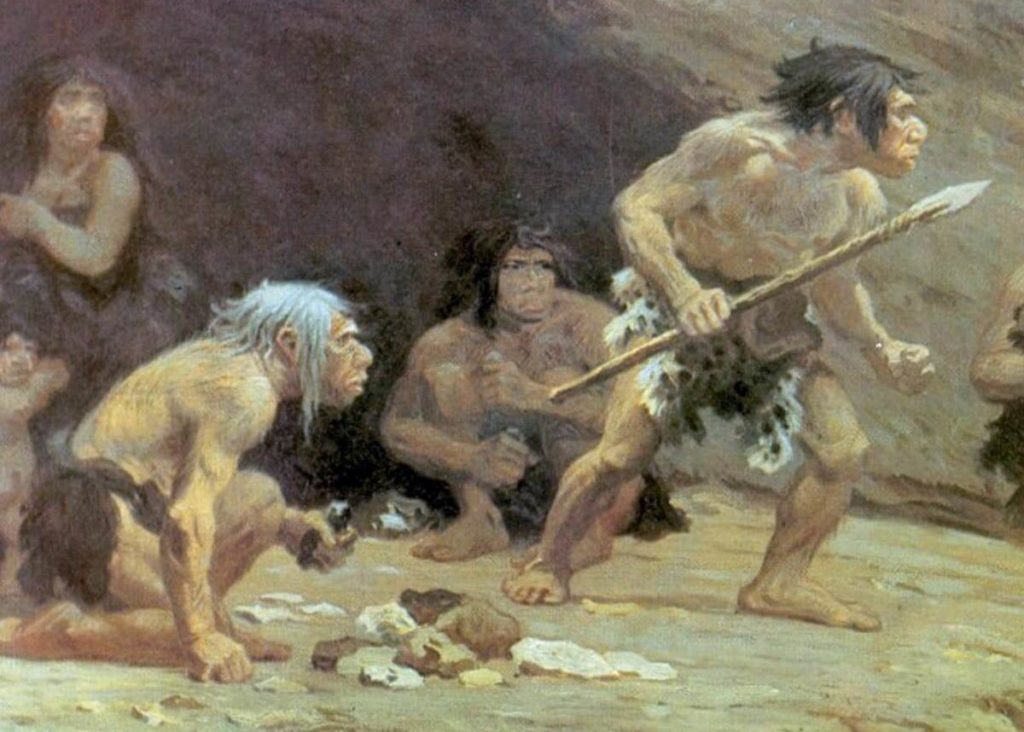
رقابت و جنگ برای منابغ غذایی یک اتفاق طبیعی و معمول در سیاره ما است. در دنیای پستانداران و بخصوص بخش میمون سانان نیز رقابت برای بقا وجود داشته است.
نئاندرتال ها زودتر از انسان ها از حدود نیم میلیون سال پیش در مناطق سردسیر اروپا و اسیا زندگی می کردند. وقتی انسان هموسپین افریقا را ۲۰۰ هزار سال پیش به مقصد سایر قاره های سیاره ما ترک کرد بلافاصله در معرض یک جنگ ناگفته با نئاندرتال ها قرار گرفت که در اروپا و آسیا، شکارچی اصلی در زنجیره غذایی بود.
باستان شناسان و مردم شناسان می گویند جنگ این دو خواهرزاده های انسان راست قامت حدود ۱۰۰ هزار طول کشید.
نئاندرتال ها با وجود آنکه ساکنین قدیمی تر اروپا و آسیا بودند و بدن ورزیده تری داشتند ولی به مرور و به چندین دلیل،جنگ جهانی شان را به انسان هموسپین باختند و نسل شان منقرض شد.
۱ – نئاندرتال ها قدرت رشد و تحول ابزارشان کند بود. در طی حدود ۱۰۰ هزار سال جنگ مداوم با انسان جدید، وضعیت آب و هوا مدام تغییر می کرد و تغییر منابع غذایی و تغییر محل زندگی می بایست منجر به اختراع ابزار شکار جدید باشد.
اما متاسفانه نئاندرتال ها به خاطر تکیه بر قدرت بازو و شجاعت شان، بهای کمتری به اختراع یا توسعه ابزار شکار می دادند.
۲- نسبت تولیدمثل نئاندرتال ها کمتر از انسان جدید بود و در قبیله های کوچکتر زندگی می کردند. انسان جدید می توانست قبیله های بزرگتری تشکیل دهد چون قدرت همیاری و سازماندهی اش بیشتر بود… در دراز مدت، جنگیدن در قبیله کوچکتر و کاهش تدریجی جمعیت، نئاندرتال ها را ضعیف تر و ضربه پذیرتر ساخت.
حدود ۴۰ هزار سال پیش اولین جنگ جهانی دو فامیل از جد انسان راست قامت با منقرض شدن نئاندرتال ها به پایان رسید. بدون شک در فاصله طولانی ۱۰۰ هزار ساله موارد متعددی از فرصت تجاوز و زناشویی های اجباری بین انسان هموسپین و نئاندرتال ها شکل گرفت و برای همین بقایای نئاندرتال ها در ژن انسان هموسپین دیده می شود.
The 100,000 Years War Between Neanderthals and Homo sapiens
https://historyofyesterday.com/the-100-000-years-war-between-neanderthals-and-homo-sapiens-65caaf781b7
Conard, N. C. & Bolus, M. Radiocarbon dating the late Middle Paleolithic and the Aurignacian of the Swabian Jura. Journal of Human Evolution 55, 886–897 (2008).
Currat, M. & Excoffier, L. Strong reproductive isolation between humans and Neanderthals inferred from observed patterns of introgression. Proceedings of the National Academy of Sciences of the United States of America 108, 15129–15134 (2011).
Finlayson, C. Neanderthals and Modern Humans. Cambridge, UK: Cambridge University Press, 2000.
Ghirotto, S. et al. No evidence of Neandertal admixture in the mitochondrial genomes of early European modern humans and contemporary modern humans. American Journal of Physical Anthropology 146, 242–252 (2011).
Golovanova, L. V. et al. Significance of ecological factors in the Middle to Upper Paleolithic transition. Current Anthropology 51, 655–691 (2010).
Green, R. E. et al. A draft sequence of the Neandertal genome. Science 328,710–722 (2010).
Harvati, K. “Neanderthals and their contemporaries,” in Handbook of Paleoanthropology, vol. III,eds. W. Henke & I. Tattersall (Heidelberg, Germany: Springer Verlag, 2007) 1717–1748.
Harvati, K., Gunz, P. & Grigorescu, D. Cioclovina (Romania): Morphological affinities of an early modern European. Journal of Human Evolution 53, 732–746 (2007).
Krause, J. et al. The complete mitochondrial DNA genome of an unknown hominin from southern Siberia. Nature 464, 894–897 (2010).
Mellars, P. & French, J. C. Tenfold population increase in western Europe at the Neandertal-to-modern human transition. Science 333, 623–627 (2011).
Pinhasi, R. et al. Revised age of late Neanderthal occupation and the end of the Middle Paleolithic in the northern Caucasus. Proceedings of the National Academy of Sciences of the United States of America 108, 8611–8616 (2011).
Smith, F. H., Janković, I. & Karavanić, I. The assimilation model, modern human origins in Europe, and the extinction of Neandertals. Quaternary International 137, 7–19 (2005).
Smith, T. M. et al. Dental evidence for ontogenetic differences between modern humans and Neanderthals. Proceedings of the National Academy of Sciences of the United States of America 107, 20923–20928 (2010).
Stewart, J. R. The ecology and adaptation of Neanderthals during the non-analogue environment of Oxygen Isotope Stage 3. Quaternary International 137, 35–46 (2005).
Stringer, C. et al. “Climatic stress and the extinction of Neanderthals,” in Neanderthals and Modern Humans in the European Landscape During the Last Glaciation, eds. T. van Andel & W. Davies (Cambridge, UK: McDonald Institute for Archaeological Research, 2003) 233–240.
